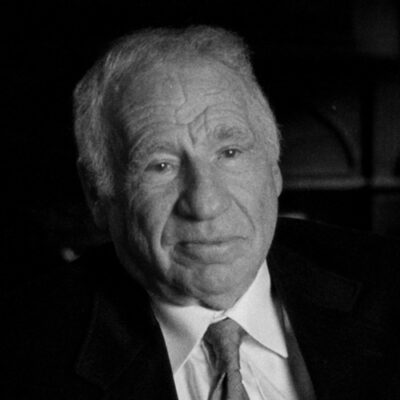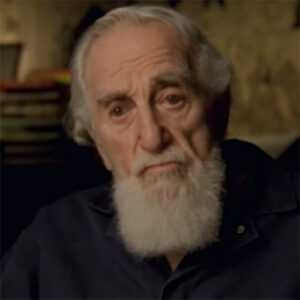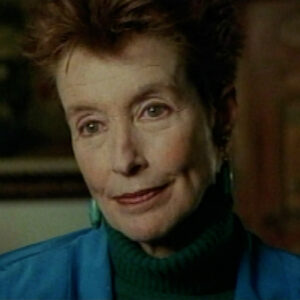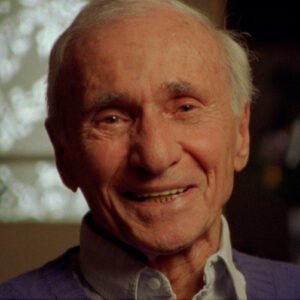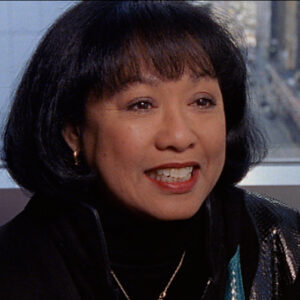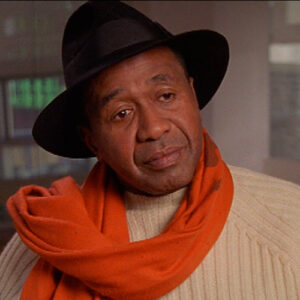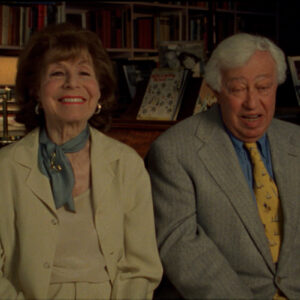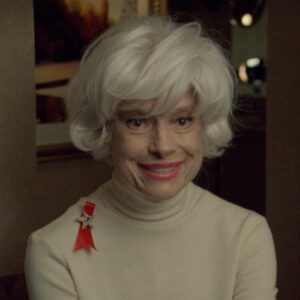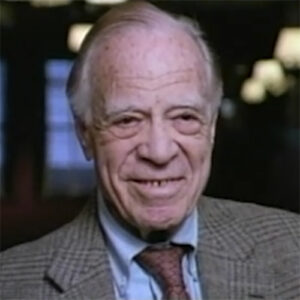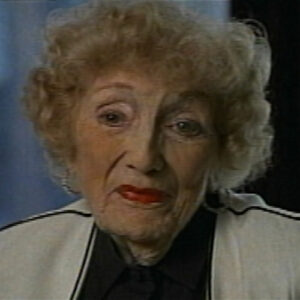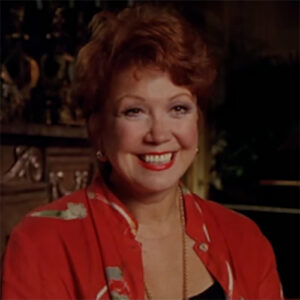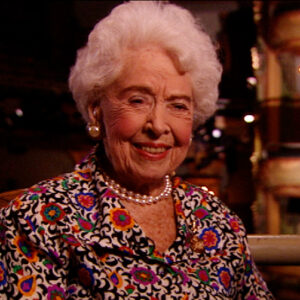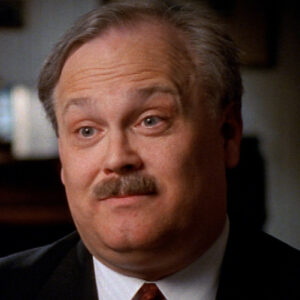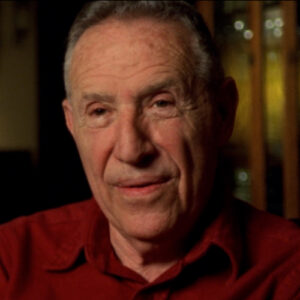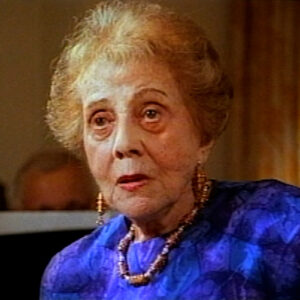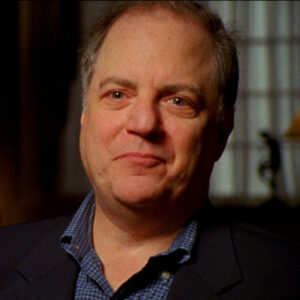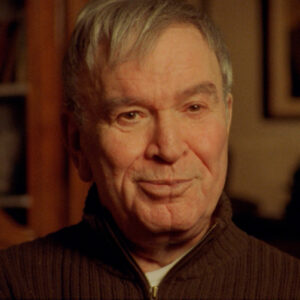Michael Kantor: What was the most popular form of entertainment in the 19th century, and why does it have anything to do with the Broadway musical?
Mel Watkins: All right, a two-part question. The most popular form of entertainment in the 19th century emerged as minstrelsy in about the 1840s. And it was blackface entertainment with white performers using cork makeup to pretend that they were black and to basically present a kind of buffoonish entertainment that. Them. That used rather simple-minded humor and basically, basically European tunes and some basically Irish dances, European dances, folk dances basically, was what it was when it started out. But the humor was, used a lot of stereotypes about black performers, obviously, or about black people. What they did was to combine European music and dance with a stereotypical vision of what black life in America was and they actually were satirizing black life. But it became a rage. In about 1840, it was one of the most popular forms around the Virginia. Minstrels, I believe, started in the 1840s in New York City and subsequently that took over before the Civil War. That was the most popular form of entertainment in the country, both in the northeast where it started, and also in the south to some extent, and it actually had spread to the Midwest by that time. Now, why was it?
Michael Kantor: And make the case, like someone says, an extra show has nothing to do with the product.
Mel Watkins: Well, when the minstrel show started out, it really did have nothing to do with the Broadway musical. Its basic tie was that it was the most popular form of stage entertainment. So the Broadway Musical is stage entertainment, but what happened to the minster show over a period of time is as it evolved, you had first of all, you had black performers taking part in minstral shows. Secondly, you had an infusion of black music. Into or syncopated music into the minstrel show. And it changed over a period of time where it lost its strictly formatted three-part presentation and went on to include various forms of entertainment. It became a variety show in effect. So that is how it was really the beginning of Broadway. And out of that, Vaudeville developed. And out of Roddell, of course, the Broadway show. Part of the diversity that was introduced into the minstrel show was African-American dance. Now, this started with a performer called William Juba Lane in about, in the early, or late 1840s. He was the first black performer to actually join a white minstral troupe. And he introduced African dance in the sense of what they call… Juba tapping. Juba in Africa is a dance where the dancers actually slap sticks against their legs or pat their legs with their hands. So what he did was to introduce a kind of syncopation into dancing that became a part of the the minstrel show presentation. And Lane was the first, as I said, the first black performer, but he also introduced the first aspect of black culture into that. That is the black dance. The minstrel show evolved and became more of a variety show and more diverse. Dance became a more important part of it. And one of the dances that first affected the altered minstral show was the cake walk. Because around the 1890s, the cakewalk became a popular dance among black traveling troops and was gradually introduced into. Black minstrel shows, and into some white minstrels shows. But the cakewalk, again, was an African dance. African slaves had adopted an African dance and used it during slavery times to actually parody their masters. It was a sort of strutting dance where it was more posturing and struting than actual dance. But it didn’t. It involved a certain carriage of the body, a certain proudness in the way you walked, and a certain rhythm in the where you walked. That dance became, about the turn of the century, became the most popular dance in America. And there were cakewalk contests all over the place. In fact, that dance, when introduced into shows, became the cornerstone for many of the shows. But also, there were other dances. Billy Kersens had introduced dances like the Black Bottom. Into his act and the shuffle. Later into the 20th century you get the beginning of a Charleston that comes into American dance and starts to affect it. These things work together with the music because the music, the syncopated music that it started along with a cakewalk, developed into what was called Kuhn songs at a certain point. Now these Kuhns songs which featured songs like All Kuhnes Look like to me was written by the black performer Ernest Hogan. The first really rhythmical music that was introduced under the American stage. The Kuhn songs developed into ragtime, and ragtime became the most popular music in the early 20th century. All of this was taken up and used on the Broadway stage. It all culminated in Shuffle Along, the show that Florian Miller and Aubrey Lyles wrote, which appeared in the 1920s. But before that, there was a gradual introduction of black dance into musicals. In this country, first into black musicals, and there were many of them at that point. Williams and Walker, by the beginning of the 19th century or 20th century, were producing black shows. And Walker went on to perform later, of course, by himself. But those shows that they produced featured the cakewalk first, then other forms of black dance and black music. And this was, as I say, a gradual evolution with more and more input as the American mainstream public accepted syncopated music, dance music, Black dance music. So it was more often used on the stage. It became a real part of the Broadway stage.
Michael Kantor: There’s music, and dance, and as the Broadway musical’s evolving, they get, as the American public is what you said at the end, they can build it. Here we go. So tell me how the things feed into the evolving Broadway musical.
Mel Watkins: During the, or at the turn of the century, black musicals and small black troops had began to introduce more recognizably black song and dance into their acts. They had dropped much of the minstrel show, pattern much of European music that had been used in minstral shows and had began introducing something else into those shows. And those shows were, some of the shows by people like Noble and Sissel, Williams and Walker. Miller and Lyles were taking to the stage in crossover musicals. They incorporated all of these aspects. They incorporated dance, they incorporated song, even some humor, humor much less than the other two. Dance and song were readily accepted by the American public. In fact, dance, the cakewalk became the first syncopated music accepted by the mainstream American public. Around 1900. After that, there were various other dances that came along. But there was a convergence of dance and music, a gradual acceptance by mainstream America, and that was then introduced into the Broadway musical and introduced into mainstream Vaudeville and finally the mainstream Broadway musical.
Michael Kantor: Let’s talk about Burt Williams for a minute. Give me a brief background. I know you probably, as you said, want to write a book about Berto Williams. But who was Berto William and what was his genius?
Mel Watkins: Well, first of all, Burt Williams was born in the Bahamas and grew up in this country and decided to go into show business at an early age. He met his partner, George Walker, in 1893. They formed a team, Williams and Walker, and became almost immediately successful. Walker was a dandy, a better dancer than Burt Williams, very flamboyant performer. Williams was low-key, was very quiet on, off the stage, very quiet. On the stage he also played a subdued personality, what he called the prototypical black. Simplified black coon, I guess he would call him.
Michael Kantor: Burt Williams generally assumed the kind of role, tell me again, he assumed the kind of stereotypical role of those of America. What was that?
Mel Watkins: On stage, Bert Williams throughout his career portrayed one character. It was the shuffling black coon, as he put it, the stereotypical shuffing black coo. It was a character that America had become accustomed to seeing on stage. That character, in fact, was one reason that minstrelsy was so popular in this country because it affirmed America’s vision of blacks. Now, Williams took this character along with his, working with his partner George Walker, these two, that character, William’s character bounced off Walker’s character who was the dandy, the flamboyant black dandy. On stage they played very well together because they contrasted so perfectly. William’s though did something to the character. He almost turned it inside out. He was able to bring a humanity to that character that had not existed before. Everyone else played the character as a total buffoon and it was totally derogatory. Williams. Invested some humanity into the character, made him a living human being, and made him someone that people could be sympathetic to. You laughed at him, but you also sympathized with his plight, and that’s what set him apart in presenting that character. He was, in that sense, he was a genius, because he became the fool who speaks with the voice of the wise man. He was the he presented a character who could make even whites sympathize with blacks to a certain extent. And that really was what set him apart from everyone else before. Besides which he was a great dancer, he was great mime, his poker bit where he does it totally by himself and plays a game of poker with other people but he’s on stage by himself, is one of the most brilliant pieces of comedy that anyone has ever seen. People who have seen it think it’s one the most brilliant pieces that anyone has ever done. It ranks up there with Richard Pryor’s Why No Other Junkie, if you wanted to talk about that kind of thing.
Michael Kantor: Just briefly compare his offstage demeanor with the books he read and so on with what he played on stage. I mean, it couldn’t be more opposite. Yeah. You start with Burt Williams again.
Mel Watkins: Burt Williams’ onstage character was totally contrary to his personality offstage. And it was something that amazed people because he was an intellect. First of all, he was very light skinned. Williams was so light skin that from a distance he probably could have passed as white. He also had very European features. So onstage, when he’d been blackened up, he looked totally different, obviously. But he also was a different person offstage, a very sensitive man. Well, Red Man. A very introverted man, as contrasted to the extrovert that he often played on stage. He read the best writers of the time, Frederic Nishy, Mark Twain. He enjoyed conversation with some of the most intelligent people of the time if they were willing to talk to a black man. And he often joked about So, thank you for joining us. About his life in America. I think one of his quotes was that living in America is fine, I’m paraphrasing this. Of course, living in American was fine except that it’s very inconvenient is the way he put it. And that’s a sense of the subtlety of his humor because he was a very avid race person. He was very aware of racism. He was not an Uncle Tom by, uh, Any way you look at it, he could not be considered an Uncle Tom. Yet often some people condemned him as being that because of the character he plays on stage. So the difference between his offstage personality and his onstage character are so immense that it baffles one’s mind, I think, to a certain extent. How did he put up with it? And I think the fact that he became an alcoholic has something to do with that. And after Williamson Walker met in 1893, there was the The producer who first saw them, I think it was in San Francisco, brought them to New York because he was so impressed with what he had seen. They appeared in a show called The Gold Bug, I believe, in 1896. And after that show, they became immediate hits. They first went to Vaudeville together, performed on the Keefe and Orpheum circuit, which were the mainstream Broadway, the Vaudeville Circus at that time. And by the early 1900s, had started to produce their own shows and produced four Broadway shows. And when I say Broadway, I mean these shows appeared actually off-Broadway. But people, that term is used in many ways. Those shows made them two of the most immensely popular teams of the time. The shows were successes in every way. They became very popular. Both because of the dance and because of Williams’ character. And the dancing was a cakewalk. Williams was an excellent cakewalker as was George Walker. Walker was more, again, more flamboyant, more lively, more energetic in the way he presented the dance. Williams was very subtle and cool in the way he represented it. So the two, again even in dance, they contrasted. The personalities were contrasted, but it again brought out the contrast in the dance and music can be used, because the ever-smiling George Walker and the arrogant, proud George Walker would do it with one way, with his head, with this chin thrust back and his shoulders thrown back, and Burt Williams would do in sort of a slouched manner. His posture was entirely different, but the rhythm of the dance was still there.
Michael Kantor: What would you consider, you know, of a landmark Broadway show for Berkley?
Mel Watkins: During the first decade of the 20th century, Williams and Walker did a number of shows. Their third show was called Bandana Land, and it was the landmark show for them. Not only because of the dance, they had by this time brought the cake walk to its most impressive presentation by them. But it also featured Burt Williams doing Nobody, a song and routine that he would later use. With Ezekiel Follies and made him very famous, or even more famous by that time. The show was not only important because of its music and the dance and that landmark presentation by Bird Williams, it was also a show which, for the first time, presented a black trickster who was successful dealing with white characters. So it was a breakthrough in that sense. This had never been really seen on the Broadway stage before, where a black outsmarts, actually. His white adversaries within the context of the play. So it was landmark in that sense. It was landmark because it was a successful show. And it brought them to the pinnacle of success, really.
Michael Kantor: Great, I love your mentioning Nobody. Just pick it up there, you know, in 1908, Burt Williams first sings the song Nobody, and it sort of becomes, don’t mention the Follies, because we’re gonna have Zeke Philp pull them in, but becomes his signature song. And what is the song about in the song?
Mel Watkins: In 1908, in the play Bandana Land, Bert Williams introduced the song Nobody. It became and is still the song that he’s most known for. It was his signature stage presentation. And the reason it worked so well for him is it complimented his character. It complimented the shuffling, seemingly inarticulate black character that he played because it’s a lawns. A forlorn song about a person who nobody loves. And the line I think we most know about that is, I ain’t never done nothing for nobody. And until somebody does something for me, I’m never going to do anything for you. I’m paraphrasing, of course. But this is what the song is about. It’s about an individual who is so So, thank you for joining us. Depressed or turned off by his treatment in society that he has decided he’s never doing anything for anyone else. Now, Burt Williams was able to take this song and use those lyrics to enhance the character that he played on stage when he did his single performances. But he also, in that play, first introduced it by himself on stage, although he was with George Walker at the time. So it became… One of the uh… The most popular songs of the twentieth century and still is a song that’s played regularly and it’s been re recorded by almost there was a sadness about the song and yet there was a tinge of humor about it because williams wood presented in such a way that he did not entirely play up to the sadness uh… The song again is about a very lonely person who has decided that he wants nothing to do with humanity because the was treating him so badly. But Williams, with a flick of the eye or a turn of the shoulders, could turn this into something that was funny, where the audience could both feel for him and laugh.
Michael Kantor: So trace, if you would, how this movement for full-length black shows kind of dies out in late, you know, around 1910, and what’s Williams to do?
Mel Watkins: After George Walker’s death in 1909, Burt Williams was of course left to perform by himself. And it was a crucial point, 1909-1910, with African Americans in show business because a number of people died around this time. Bob Coles, Ernest Hogan. A few years later. Billy Curzins. So you had many of the featured black performers of the period who died within about six years. And Burt Williams was left as the premier black stage performer. It was at this point that Ziegfeld came along and offered him a job. He worked Vaudeville. Williams had worked Vaudville first. But Ziegfel came along, and offered him a job as a star performer. Which was unheard of at that time, because most black performers did not work with white shows. There were a few, and it happened every once in a while, but they were not featured performances. They were always given the worst time to appear in the variety show, and they were treated as if they were lesser than the featured white performers. Burt Williams, however, from the moment he started with the Ziegfeld Follies. Was considered a star. And the two men apparently got along very well, because Williams never wanted to leave there. He liked it. He felt he made certain compromises because he accepted certain things about what had to happen because of the nature of white audiences and what they would accept and what they would not accept. And Ziegfeld made some compromises also. Williams was not required, for instance, to travel with the show when it went south because it wouldn’t have worked. A black performer simply could not have been presented as a featured performer there. On the other hand, Williams agreed never to appear on with a white woman. Because that would have been something that would upset audiences at the time. So there were compromises on both sides. But there was mutual respect between these two guys. And it seemed to me that when I read about it, I picture it as a situation where Williams felt that Ziegfeld had given him the greatest opportunity of his life. With that opportunity, he was able to develop himself as a performer in a way that he would not have been able to develop within the context of Broadway musicals and other venues so that he really became at that point the performer that we always remember him as, more so than when he worked with George Walker because by this time he had learned mime, he had become a different type of performer. He was a single act. And he used every bit of his talent. Both impressed the audience and expressed himself. And that character that he played, that stereotypical black shuffling buffoon had now become so rich, so different than anyone, than any character or any presentation that he had had on stage before that Williams could present him in a way that audiences simply loved him. And it was strange, because it’s one these strange things where… White audiences loved it because in a sense, he was playing the shuffling black. But yet, they had to accept the fact that the humanity was being presented at the same time. Black audiences loved it because they saw through the cleverness of the fool making these wise comments, and the fact that there was a twinkle in his eye when he said certain things, and that the irony was there at all times. They saw it as something entirely different. So Williams was able to play both sides of the racial picture at the time, or both sides of the racial audience at the same time. And satisfy both of them. Eddie Canada talked about how much he had learned from Burt Williams, and they were apparently fairly good friends offstage. W.C. Fields perhaps saw more into William’s character because what he… What he saw was really both the person who appeared on stage and the man underneath. And I’m not sure what their relationship was, but it was Fields who said that Williams was the funniest man I ever saw and the saddest man I every knew, which is, I think, one of the most revealing statements that any performer has made about another performer at that time, particularly by a white performer looking at a black performer at the time. And feels, I don’t think is known for his sympathetic. Qualities that much feels was usually known as a is a pretty satirical and uh… Well, as a realist who didn’t play around with sympathy and didn’t have a soft side. But that shows it feels or understood much more about Williams than a lot of people did.
Michael Kantor: Great. Just let us know, in a sort of setup for that whole thing. Williams appeared in all of the greatest follies. He’s in the follies with Will Rogers and Eddie Cantor. WC fields and all the dancers and that’ll just help us, you know do a little okay
Mel Watkins: I mean, I can just say the list of performers who were in the Follies at the same time as Burt Williams includes Eddie Cantor, W.C. Fields, Will Rogers, all of the notable performers of that period appeared about the same as he did. And still he was considered the star attraction for much of the time he was on stage. It gives you some idea of the magnitude. Of the man as a performer.
Michael Kantor: Why didn’t Williams, like some of the other great comics of the time, give up the blackface mass?
Mel Watkins: Black performers of that time, most black performers of that time worked in blackface. And that was not only the tradition, but it was required by many white owners and stage managers. It was what was expected of black performers. It was considered to be. A little bit too. What’s the proper word? Uppity, I guess, too. If one performed without the black bass, it was, that is for white audiences. White audiences assumed that a black performer performing without black bass was being, was stepping out of line, out of his place to a certain extent. And there were a few who did. Noble Cissell, I guess, and Hugh B. Blake were two who performed on Broadway or in Vaudeville about the time it did not wear blackface. But Burt Williams loved the blackface because it was perfect for his character. And again, his act essentially revolved around this character who was a slave and who was an inarticulate and who is shuffling. On the surface appeared to be very stupid. The epitome of the stereotype. Without the blackface, Bert Williams would have couldn’t have played that character, to be quite frank about it. It was essential for him to keep it. So while other performers, including Eddie Cantor and some other people, developed and moved on without it, Williams considered it essential to his character. Not so much because it was required for him, although there were restrictions on other black performers, and they were forced to use it. Williams probably could have gotten away without it, because I think his relationship with Ziegfeld was such that if he had wanted to, he might have gotten way without it. One of the stories that reflects Burt Williams outside of position with the entertainment industry at that time was that even though he was a star of the Ziegfield Follies, he went to the theater one day and noticed that no one was there except stagehands. Didn’t talk to him because he never had a very good relation with the stagehands anyway, who were all white. When he went to his dressing room, we found out that none of the other performers were there. And finally, he came out and someone told him that there had been a strike. And he simply looked around and walked off. The thing is that no one had bothered to tell him. And neither the stage hands or the stars, his other performers, had told him anything about it. And it just shows the way he was treated and… Mistreated, even though he was a star, he was the number one star of the show, they simply let him walk to the theater and find out for himself. Another story about Williams is the fact that, and I’m not sure if this is a true story or not, is that supposedly he walked into a white bar once in order to drink. This was in New York City near the theater. The bar owner served him the drink, but charged him some outrageous price, apparently 10 times what the drink would normally cost. And after Williams had drank or finished the drink the bar tender took the glass and threw it on the floor, breaking the glass. Williams simply looked at him without getting angry and said, I’ll have two more. He drank the next two. The same thing happened. And apparently he drank a couple dozen drinks, forcing the bartender to break. All those glasses and simply walked out and laughed at the man as he walked out. This was the way, again, he treated racism, it was as if he knew it was there, he didn’t flail against it, he simply treated it with a certain kind of irony and a certain kind of disdain and I think that says something about his personality.
Michael Kantor: And let him finish sawing. But what about what happened toward the end of his career? He finishes the Ziegfeld Follies. I don’t know, I think he dies in 23, but in the early 20s, we don’t have to be specific about dates, he leaves the Zigfield Follys and he does a solo shower, goes out on the road, but clearly something was eating at him and it manifested itself in the alcoholism, you know? Yeah. Tell us then.
Mel Watkins: I think by the end of his career, the ambivalence that he felt towards the society, the conflict that he thought towards performing as a star and being treated as a second class citizen in the real world had finally gotten to him. He had gradually began drinking after Walker’s, after his partner, George Walker’s death. And by the early 1920s, it became a serious problem for him. He was, again, a very sensitive man. A man who didn’t have very many friends in his profession. He was very close to his wife, but he didn’t have friends in this profession. He was looked at as an outsider. And all this gnawed at him. It ate away at him, and finally, he succumbed to a drinking habit that ultimately killed him. Okay.
Michael Kantor: Actually, prohibition comes in, so come to think of it when he’s drinking later, but anyway.
Mel Watkins: Well, you know, around that time. But after the death of George Walker, Williams began drinking more. He had apparently become more affected by the conflict between his role on stage as a star and his position in society as a second class citizen. He had very few friends in the industry, and it was very difficult for him to find people to talk to. He often drank alone. Although his wife was, he was very close to, although he was close to his wife, she did not accompany him that many times. He traveled all the time. So he was a man who was very much alone. And he turned to drink and ultimately succumbed to that habit which destroyed him as it had destroyed, in fact, some other black performers during that time. Williams once said about the character that he played, the character he made famous on stage, that I must study his movements because he is not me. And again, it brings up the contradiction between this very sensitive, very intelligent man, this very well-read man, who was playing a character that epitomized everything that America thought about the black man, that isn’t being stupid, lazy, inarticulate. He was the shuffling coon. And Williams… Feeling about this was that, two, it was an expeditious way of saying something about America because within the voice of that character, through irony and through observations, witty observations, he could make it clear that even that character was not the numbskull. Unfeeling buffoon that America would like to think that he was because even that character to Williams became a character who was very articulate and in an ironic way. He had to deal with the dichotomy within himself and the contradiction between his personal life and the character he played. And I think he did a marvelous job of because. To be able to perform that way when you’re as smart, as intelligent as he was, means that you can put aside all of your personal feelings for a brief moment while you’re on stage, and to portray someone who’s imagined by someone else and someone who is a focal point of a lot of the racist feelings in the society, but at the same time, to give that character humanity. It’s almost like throwing it back in your face and saying, OK, you think this character’s stupid. You made up this myth. But no, not only is he not stupid, not only is not articulate, he’s smarter than you. He’s a trickster. What he’s saying is something that has much more depth than you could ever imagine. And I think Williams understood that and was able to move from side to side, using that character as a mask in a certain sense, but also using him as a misdirected way of having a dialog. With mainstream America.
Michael Kantor: Broadway’s called the great white way for the light bulbs, of course, but was Broadway a land of opportunity for African-American performers, or was it in fact using those people to perpetuate stereotypes that we just assumed have disappeared?
Mel Watkins: By the 20th century, Broadway was one of the, or presented one of the greatest opportunities. African Americans in this country. Since many jobs were not open to them, many professions were not open them, they could perform. Even sports, at that point, as a matter of fact, was highly segregated. Later on, sports and entertainment have been brought up as the things that the two options of blacks or minorities have in this country. But at that, it presented a great opportunity to them. Yes. It did have… Some limitations in the sense that in most instances they had to don blackface before going on to perform. If we’re talking specifically about the early 20th century from, say, 1890 to the 1920s, then I don’t think that blackface was a serious problem for blacks themselves. That is, the black performers themselves. I think that it presented a problem to some other blacks and some have complained angrily about the fact that blacks were forced to wear blackface. Or chose to wear blackface in some characters because blacks wore blackface even when they were performing before blacks in black shows. It had become a tradition. It had became simply a stage mask at this point. It was not, it did not carry or did not have the same implications that it had had when minstrels first started in the 1840s and whites had worn blackface. By this point, it had become almost the mask of a clown. But it was. Associated with humor, associated with the comic presentation on stage. So that for the black performer, it became something that allowed him to step into character as again, much like the cloud. And variety shows of the period we’re talking about are very much associated with a circus because the circus had become a very strong and important aspect of traveling shows at that time. In fact, some traveling shows travel within a circus. So the clowns donning a mask with a big nose and the colorful face was simply another instance of performers donning masks. And blackface, to a certain extent, is that. The problem is that it also has racial overtones in this society. So that you have people who were very upset about it and other people who felt that it meant more than just a performance mask. They thought that it said something about race. And that was on both sides, both blacks and whites. I think that the minority of or the majority of blacks rather, felt that it didn’t have very much importance. They recognized it as a ruse, they recognized it as a mass, they recognize it as gimmick that a performer used in order to present a certain character on stage. And that blackface actually helped them present that character, as in the case of Burt Williams.
Michael Kantor: What was Shuffle along, briefly, and why was it a landmark in the early 20s?
Mel Watkins: Well, Shuffle Along came or appeared, debuted at a time when a few other black-oriented shows had gotten near Broadway. But Shuffle along came along as one of the most popular shows to ever hit Broadway. The reason is, I guess, threefold. It’s one, because of the people who created the show. You had Miller and Liles who had had several successful Off-Broadway or traveling shows produced by that time. You had the music written by Hubie Blake and Noble Sissle who were two of the outstanding Broadville performers and writers at that time, you had stars like the young upcoming Josephine Baker who appeared in the chorus line in that show. Besides the people who created the show, who actually performed, you have the introduction of dances. Never been seen on Broadway before at that time. These dances, some of them had been seen in other places, in African-American variety shows that had been traveling and so forth, but had not appeared on Broadway. You had the music. More straightforwardly syncopated and rhythmical than any that they had seen on Broadway before. Because you had two, again, you go back to the songwriters. You had Hubie Blake and Noble Sissle, and these people did not tone down the music. They made it straight out. It was energetic, it was rhythmic, it… Rousing music so when you put all these things together you get a show that that The critics loved It was energetic it flowed musically the dance was new the audiences loved it It was one of the greatest things they had Broadway at that time
Michael Kantor: just briefly touch on you know this is the period when other composers like Gershwin and Berlin who of course was doing his own syncopated thing earlier but it can’t everyone can’t help but sort of be taken up by I think Langston Hughes sort of said they gave a a little kick to the the Harlem Renaissance sort of pre-pre-jazz kick I mean it really helped kick off this era that we think of as.
Mel Watkins: The roaring 20s, yeah.
Michael Kantor: So shuffle along, it’s important why.
Mel Watkins: Shuffle Along also was very much a part of the roaring 20s. It was a part a whole movement within the society. It was an urban show that appealed to Harlem, to the people, the urban community in Harlem at that time. The intellectuals in the Harlem Renaissance thought that it was a great show. They felt that it brought, it started to focus on jazz rather than, again, that country or agrarian scene that a lot of black shows had focused on before. Even Burt Williams was still doing something that had to do with the agrarian scene, with the rural stereotype. You now are getting, these were new stereotypes, if you want to put it that way. At least there were new characters. There were characters who were jazzy, who were upbeat, who were supposedly smart. And I must say, although the humor was not that different from a lot of the humor before that, it was still the kind of Amos and Andy humor that Florina Miller would go on and do later on. The outside of the humor It was terrifically upbeat. It was a tremendous progress in terms of black theater. Because Josephine Baker, in fact, is said to have introduced the comic chorus line figure in that show by her addicts on the chorus line. There are these beautiful women on the chorus line, and that was something new for many black shows also. But within that context, you had Josephine Baker introducing humor in that area. And again, the music, from what I understand, was terrific. I’ve only heard a few of those songs. Even though they’re There is not one song that came out and lasted the way Gershwin or some of the other Broadway songwriters’ songs have lasted. Taken as a whole, that music had a tremendous impact on theater, and the dance had even more impact. Even into the 90s and 80s, 80s and 90s I think, some people admit, or most people admit that that show established the kind of rhythmical jazz or in advance, that would. Actually mold the Broadway presentation to a certain extent. The score of Shuffle Along included one song that became a breakout song, or at least is remembered by most people, although most of the score was kind of forgettable, forgettable in the sense of having standout songs. The fact is it had the energy, it was there for the dance, it was to enliven the entire production. But the one song that it seems to me that people might still remember would be I’m Just Wild About Harry. And that song was popular for many years. And Harry Truman, I believe, used it as part of his campaign when he ran for president about 30 or 40 years later. People still obviously remember that one. They don’t associate it with that show. In most cases, they simply think that, and I guess many people think that Harry Truman had it written himself. I’m not sure. But the other song was Baltimore Buzz that I remember, and think it was used in a movie that came out later on after the show opened.
Michael Kantor: So with the end of World War II and the advent of the book musical with more serious themes, what’s your take on African-American musicals and why they sort of, there’s a couple quick ones right after the war and then there’s none for a good portion of the 50s. Why has that sort of wave happened?
Mel Watkins: I think that… After World War II, we had a very strange period in American culture. For a short period of time, at least in film, there were some very serious movies that came out. Then there were protests about those movies. And a certain segment of the black or African-American community wanted movies that address more serious subjects or address the black community in a more realistic manner. And Hollywood’s reaction, and I think this goes for the Broadway stage also, was simply to avoid portraying blacks at all. So what you had in, basically, Have a great day. By the mid-50s was a period where there weren’t many Blacks anywhere, on television, in film, or on Broadway, and even Carmen Jones, a show that was very popular at that point, was criticized by many Black intellectuals because it again portrayed Blacks in a way that… Those intellectuals wished we could forget about. That is that there was again a, although it was urban, there were attitudes in it and there were stereotypes within that film that blacks intellectuals wanted to eradicate from the public mind to a certain extent. This was a very strange period, very highly politicized period. So it was very difficult for a black musical to come along or anyone to do a black musical at that point. That satisfied everyone, that they felt would be entertaining for the main, for mainstream America who still wanted to see blacks in the post-civil rights mode and for blacks themselves who were moving quickly towards civil rights to a fight for equality and wanted to see these things represented in the media. So very few plays could do that, particularly musicals. It seems to me that this was an inappropriate time and it’s reflected in what actually occurred. There were very few. Black musicals on Broadway at that point. It’s a tricky time because mainstream audiences wanted to see blacks presented in the pre-civil rights mode. They wanted to see the familiar stereotypes, the ones they had become accustomed to. And blacks, on the other hand, were moving towards a different kind of society. They were making a move towards equality, towards equal rights, towards a more just society. And they didn’t want anything to do with those previous stereotypes. In the 1970s, there were riots in the streets. There was a militant movement by blacks. It was really the early 1970s I’m talking about. There was really not the time for musicals which were joyous. The black mood was anything but joyous at that moment. So that you didn’t really see many musicals in the early 70s. By the latter part of the decade, you started to get. A different kind of show on Broadway. You went back to the kind of shows. Celebrated black life, that dealt with the joyous aspect of black life. To a certain extent, it was because of the period, there was a relaxation and tension among blacks and whites in the society. There was a feeling almost that, well, maybe we’ve settled this. Maybe it’s okay. And it was a perfect time to go back and take a look at those past periods, in cases with those shows. The vision of black life, even though it wasn’t all good, as shown in those shows, was very positive. It was freewheeling. It was fun. It was laughter. And it was exuberance. And this is something that could not have been done earlier in the decade. Sometimes I’m amazed at the change in black humor that’s gone on between menstrual shows and now, from a Totally derogatory portrait of blacks. A certainly more realistic portrait, a period where blacks had to pretend to be stupid in order to be heard to a time when they can speak out and do what they want. It’s amazing to me because you can take a show like Whoopi Goldberg’s show, one woman’s show which was some of those brilliant humor scenes on Broadway, I think, and that I guess in the 80s. That show is such a broad step from what you had at the beginning. The black appearance with comedy on the Broadway stage, that it still amazes me. The stereotypes of all being gone. Now Whoopi Goldberg and her show is actually playing with those stereotypes and reversing them. You had a show like Colored Girls by Ntozake Shange, which was another show that parodied. The perception of black women by the mainstream audience and by black men also and made fun of it and was a delightfully comic show at the same time being very serious and very positive about black life. So the change has been just tremendous. And you have even people like Richard Pryor who have appeared near Broadway, if not on Broadway, and have been very successful, have brought a kind of ironic, satirical, in-your-face humor to Broadway that never could have occurred before. And I think this is also. Affected shows to a certain extent. It’s been the quips by characters now on the Broadway stage, quips by black characters that is, are much more acid, much more cutting, could never have happened before. So the whole thing, the entire presentation of black comedy has transformed totally from a submissive, indirect, oblique kind of comedy to an in-your-face direct kind of And characters can be presented within that mode without upsetting anyone, white or black audiences. And it’s a tremendous change.
Michael Kantor: Alright, so what does the Broadway musical represent about America?
Mel Watkins: To me, to me, coming from or having been brought up in Ohio and far away from the Broadway stage, it represented what entertainment was about to a certain extent. When I was living in Ohio, I always wanted to get to New York and one of the first things I wanted to do was go to a theater. One of the first things I always wanted to do was go to a theater and see a Broadway show, and it was within the first week after getting here. That’s exactly what I did. But I think the reason it represents that to me is because before I ever knew about the African American tradition on Broadway, I knew about plays like Oklahoma and so forth, which to me is a play that’s purely American, a celebration of something that’s kind of corny, but still very American. And it’s almost like that statement is American as apple pie. That’s what Oklahoma stood out for or represented to me. And I always looked at it that way. That’s almost Broadway to me when I got to know it more, when I get to see that it was much more sophisticated than that. And there are dramas that are dark and sophisticated that there were African-American plays that used performers in blackface. And that Broadway tied in and represented or reflected the entire range of American society and its entire cultural evolution, then I started to respect it in a different way. As I said, though, my first opinion, my first, the way I first saw Broadway was Oklahoma and that sort of corny musical that had delightful songs and was almost. Pollyannish in terms of what it represented. And I still think of it that way to a certain extent.

